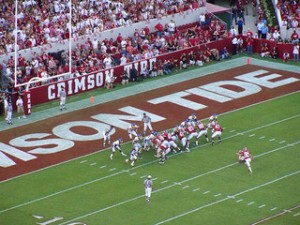How Much Do Football Wins Pay Off for a College?
An NBER paper by Michael L. Anderson looks into the how a university’s football performance affects its academic performance:
Spending on big-time college athletics is often justified on the grounds that athletic success attracts students and raises donations. Testing this claim has proven difficult because success is not randomly assigned. We exploit data on bookmaker spreads to estimate the probability of winning each game for college football teams. We then condition on these probabilities using a propensity score design to estimate the effects of winning on donations, applications, and enrollment. The resulting estimates represent causal effects under the assumption that, conditional on bookmaker spreads, winning is uncorrelated with potential outcomes. Two complications arise in our design. First, team wins evolve dynamically throughout the season. Second, winning a game early in the season reveals that a team is better than anticipated and thus increases expected season wins by more than one-for-one. We address these complications by combining an instrumental variables-type estimator with the propensity score design. We find that winning reduces acceptance rates and increases donations, applications, academic reputation, in-state enrollment, and incoming SAT scores.
By winning five games, Anderson estimates that a school could expect donations to increase by as much as $682,000:
For FBS schools, winning football games increases alumni athletic donations, enhances a school’s academic reputation, increases the number of applicants and in-state students, reduces acceptance rates, and raises average incoming SAT scores. The estimates imply that large increases in team performance can have economically significant effects, particularly in the area of athletic donations. Consider a school that improves its season wins by 5 games (the approximate difference between a 25th percentile season and a 75th percentile season). Changes of this magnitude occur approximately 8% of the time over a one-year period and 13% of the time over a two-year period. This school may expect alumni athletic donations to increase by $682,000 (28%), applications to increase by 677 (5%), the acceptance rate to drop by 1.5 percentage points (2%), in-state enrollment to increase by 76 students (3%), and incoming 25th percentile SAT scores to increase by 9 points (1%). These estimates are equal to or larger than comparable estimates from the existing literature.


Comments